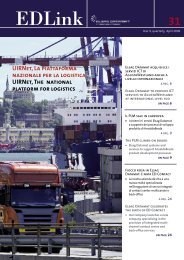Scarica numero di ED Link - Elsag Datamat
Scarica numero di ED Link - Elsag Datamat
Scarica numero di ED Link - Elsag Datamat
You also want an ePaper? Increase the reach of your titles
YUMPU automatically turns print PDFs into web optimized ePapers that Google loves.
FOCUS<br />
È proprio per questi motivi che stupisce<br />
doppiamente la <strong>di</strong>sattenzione con cui<br />
l’Italia, sia a livello politico sia (ed è ancor<br />
più grave) a livello economico-produttivo-impren<strong>di</strong>toriale,<br />
guarda ai gran<strong>di</strong><br />
fenomeni che l’Unione europea sembra<br />
intenzionata ad accelerare: fenomeni relativi<br />
all’applicazione delle nuove tecnologie<br />
<strong>di</strong> trasporto intelligente (è stata<br />
approvata nel luglio scorso la <strong>di</strong>rettiva<br />
comunitaria che imporrà un vero e proprio<br />
cambio <strong>di</strong> marcia in materia), ma<br />
che riguardano anche il cosiddetto action<br />
plan che la Commissione europea<br />
ha trasmesso sempre a luglio al Parlamento<br />
<strong>di</strong> Strasburgo e che prevede una<br />
serie <strong>di</strong> misure innovative per quanto<br />
concerne la sicurezza stradale. Action<br />
plan che muove da numeri a <strong>di</strong>r poco<br />
drammatici: ogni anno nel nostro continente<br />
si registrano 35.000 vittime della<br />
strada, in gran parte nella fascia più giovane<br />
della popolazione, con un milione<br />
e mezzo <strong>di</strong> persone gravemente invalidate<br />
in incidenti stradali e un costo per<br />
la collettività che si aggira attorno ai 130<br />
the major phenomena which the European Union<br />
seems intent on spee<strong>di</strong>ng up. These phenomena<br />
relate to the introduction of new intelligent<br />
transport technology (last July a community <strong>di</strong>rective<br />
was approved that introduces a step<br />
change), but also the so-called action plan sent by<br />
the European Commission in July to the European<br />
Parliament in Strasbourg, containing a series of<br />
innovative road safety measures. This action plan<br />
is based on statistics than can only be described<br />
as dramatic: each year in Europe there are 35,000<br />
deaths on the roads, most of them people in<br />
younger age bands, and a million and a half serious<br />
permanent injuries, costing the community a<br />
total of about 130 billion euros.<br />
The European Parliament’s green light for the Intelligent<br />
Transport System (ITS) <strong>di</strong>rective should<br />
encourage a further acceleration. ITSs integrate<br />
innovative ICT systems with transport engineering<br />
and traffic management mechanisms, using<br />
satellites to collect<br />
traffic data and exchange<br />
information<br />
between vehicles and<br />
road infrastructures.<br />
The goal is to increase<br />
road safety, improve<br />
the efficiency of passenger<br />
and goods<br />
transport, and reduce<br />
environmental impact.<br />
Accor<strong>di</strong>ng to the<br />
estimates prepared by<br />
the EU (which has earmarked<br />
160 million<br />
euros over the last<br />
three years for research<br />
in this sector),<br />
the application of this<br />
technology to cars,<br />
trucks and road sys-<br />
32<br />
miliar<strong>di</strong> <strong>di</strong> euro.<br />
Il via libera del Parlamento<br />
europeo alla <strong>di</strong>rettiva sugli<br />
Intelligent Transport System<br />
(ITS) dovrebbe favorire un’ulteriore<br />
accelerazione. Integrando<br />
sistemi ICT innovativi<br />
con l’ingegneria dei trasporti<br />
e con i meccanismi <strong>di</strong> gestione<br />
del traffico, gli ITS permettono<br />
– anche grazie<br />
all’ausilio dei satelliti – <strong>di</strong> raccogliere<br />
dati sulla circolazione<br />
stradale e <strong>di</strong> scambiare<br />
informazioni tra veicoli e infrastrutture<br />
viarie. L’obiettivo<br />
è aumentare la sicurezza<br />
delle strade, migliorare l’efficienza<br />
del trasporto sia merci<br />
che passeggeri e ridurne l’impatto<br />
ambientale. Secondo le<br />
stime dell’Ue (che nell’ultimo<br />
triennio ha stanziato 160 milioni<br />
<strong>di</strong> euro per la ricerca in<br />
questo settore), l’applicazione<br />
<strong>di</strong> tali tecnologie ad automobili,<br />
mezzi pesanti e reti<br />
viarie consentirà <strong>di</strong> evitare<br />
ogni anno oltre 5mila morti<br />
in incidenti stradali e <strong>di</strong> tagliare<br />
<strong>di</strong> circa il 10% i costi dovuti<br />
alla congestione del<br />
traffico (stimati all’1% del<br />
prodotto interno lordo europeo).<br />
Per l’implementazione dei sistemi<br />
intelligenti <strong>di</strong> trasporto,<br />
la <strong>di</strong>rettiva europea<br />
in<strong>di</strong>vidua quattro azioni prioritarie:<br />
la prima è relativa alla<br />
raccolta dei dati, la seconda<br />
alle informazioni sul traffico,<br />
la terza al servizio unificato<br />
“eCall”, la quarta alle aree sicure<br />
<strong>di</strong> parcheggio per i mezzi<br />
pesanti.<br />
Fra gli elementi più significativi<br />
del progetto ITS comunitario<br />
figura “eCall”, il sistema<br />
<strong>di</strong> sicurezza a bordo degli autoveicoli<br />
che, in caso <strong>di</strong> sinistro<br />
grave, compone<br />
automaticamente il 112 (il<br />
<strong>numero</strong> unico <strong>di</strong> emergenza<br />
europeo). Una volta che sarà<br />
utilizzato su larga scala, il <strong>di</strong>spositivo<br />
potrebbe salvare almeno<br />
2.500 persone l’anno,<br />
riducendo così le conse-



